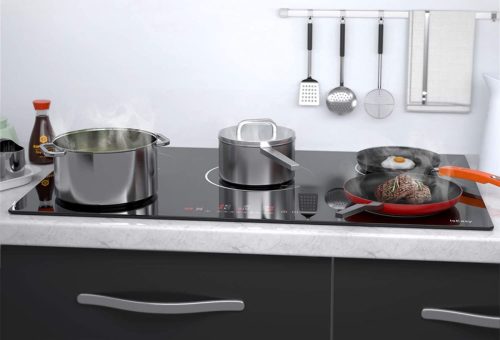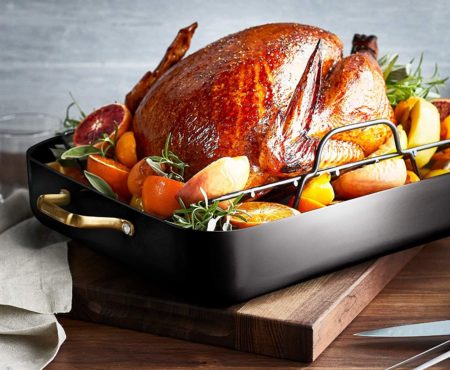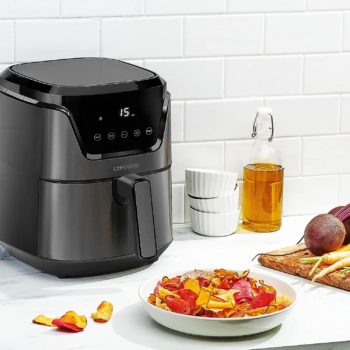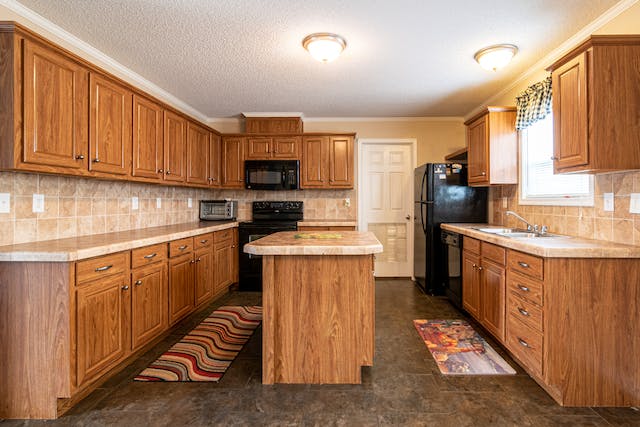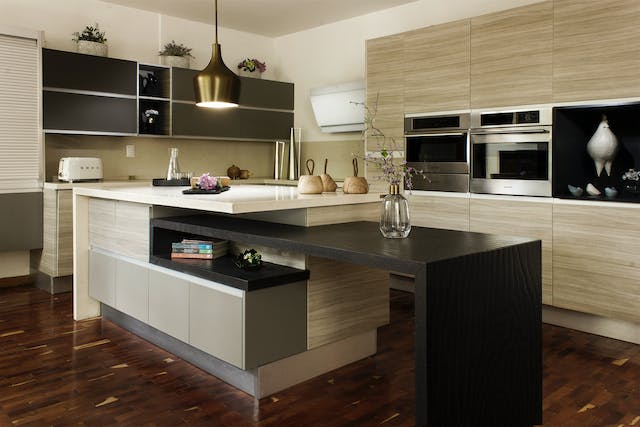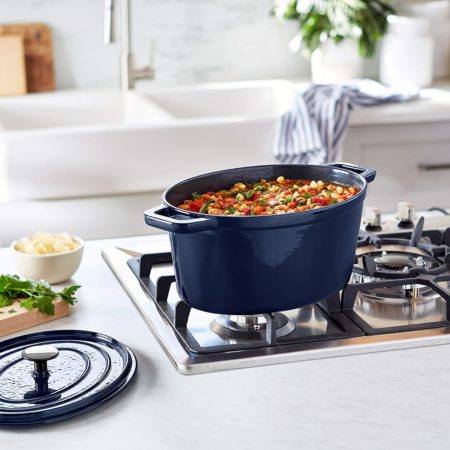Welcome to the heart of your home, where memories are made, meals are shared, and laughter echoes through the walls. Your kitchen is more than just a space for cooking; it is a symbol of warmth, comfort, and togetherness. And what better way to enhance this sacred space than with the right flooring?
We will guide you through a world of kitchen flooring ideas and materials, helping you find the perfect match for your unique style and needs. From the timeless elegance of hardwood to the versatile charm of vinyl, we will explore a range of options that will transform your kitchen into a place of both beauty and practicality.
However, choosing the right flooring goes beyond aesthetics. It’s about creating a sense of belonging, a space that reflects who you are and where you belong. So join us as we dive into the world of kitchen flooring, and discover the materials and ideas that will turn your kitchen into a true haven.

1. Exploring Hardwood Flooring Options
Let’s dive into the world of hardwood flooring options and discover the endless possibilities for transforming your kitchen into a warm and inviting space. When it comes to kitchen flooring, hardwood is a great choice that adds a touch of elegance and charm to any home.
With so many options available, you can find the perfect hardwood flooring that suits your style and needs. One popular hardwood option is oak flooring, which offers a timeless and classic look. Oak flooring comes in a variety of colors and finishes, allowing you to create a customized look that matches your kitchen decor. Another popular choice is maple flooring, known for its durability and natural beauty. Maple flooring is a great option for those who want a light and airy feel in their kitchen.
If you’re looking for something more unique, consider exotic hardwoods like Brazilian cherry or mahogany. These woods bring a touch of luxury and sophistication to your kitchen, making it a standout space in your home. No matter which type of hardwood flooring you choose, you can be sure that it will add warmth, character, and value to your kitchen.
2. Choosing the Right Tile for Your Kitchen
When selecting the perfect tile for your culinary space, it’s important to consider the visual appeal and durability. You want a tile that not only looks great but can also withstand the daily wear and tear of a busy kitchen.
Here are three options that will not only make your kitchen look stunning but will also provide the durability you need:
- Porcelain: This type of tile is known for its strength and resistance to moisture, making it a perfect choice for kitchen floors. Porcelain tiles come in a wide range of colors and patterns, allowing you to create a unique and stylish look for your kitchen. Plus, they’re easy to clean and maintain, making them ideal for a busy cooking space.
- Ceramic: Ceramic tiles are a popular choice for kitchen floors due to their affordability and versatility. They come in a variety of colors, shapes, and sizes, allowing you to create endless design possibilities. Ceramic tiles are also resistant to stains and scratches, making them a practical choice for a high-traffic area like the kitchen.
- Natural stone: If you want to add a touch of elegance to your kitchen, natural stone tiles are the way to go. Options like marble, granite, and slate not only look beautiful but also offer exceptional durability. Keep in mind that natural stone tiles may require more maintenance than other types, but the luxurious look they bring to your kitchen is worth it.
With these tile options, you can create a kitchen that not only reflects your style but also withstands the demands of daily cooking. Choose the one that resonates with you and enjoy a kitchen that truly feels like home.
3. The Pros and Cons of Laminate Flooring
On the positive side, laminate flooring offers a wide range of styles and designs, allowing you to find the perfect look for your kitchen. Whether you prefer a sleek and modern aesthetic or a warm and rustic feel, there’s a laminate flooring option for you. Additionally, laminate flooring is known for its durability and resistance to scratches, stains, and fading. This makes it an excellent choice for busy kitchens where spills and messes are common.
However, it’s important to note that laminate flooring is not without its drawbacks. One of the main concerns with laminate flooring is its susceptibility to moisture damage. While laminate flooring is water-resistant to some extent, excessive exposure to water can cause swelling and warping. This means that you should be cautious when using laminate flooring in areas prone to spills or high humidity. Another disadvantage is that laminate flooring can’t be refinished like hardwood, so any damage or wear will require replacement rather than repair.
Laminate flooring offers an affordable and easy-to-install option for your kitchen. It comes in a variety of styles and is highly resistant to scratches and stains. However, it’s important to consider its vulnerability to moisture damage and the fact that it can’t be refinished. By weighing the pros and cons, you can make an informed decision that best suits your kitchen flooring needs.
4. Vinyl Flooring: A Versatile Choice
Vinyl flooring is a versatile option that offers a wide range of styles and designs to suit any home decor. Whether you prefer a rustic farmhouse look or a sleek modern vibe, vinyl flooring has got you covered.
Here are some reasons why vinyl flooring is a great choice for your kitchen:
- Easy to clean: Vinyl flooring is resistant to stains and spills, making it a breeze to clean up any messes that may occur in the kitchen. Just a quick wipe with a damp cloth and your floor will look as good as new.
- Durable and long-lasting: Vinyl flooring is known for its durability. It can withstand heavy foot traffic and is resistant to scratches and dents, making it perfect for a busy kitchen where accidents are bound to happen.
- Moisture-resistant: Vinyl flooring is highly resistant to moisture, which makes it an ideal choice for kitchens where spills and splashes are common. You won’t have to worry about water damage or mold growth with vinyl flooring.
- Affordable: Vinyl flooring is a budget-friendly option that offers great value for your money. You can achieve the look of more expensive materials, such as hardwood or tile, without breaking the bank.
With its versatility, easy maintenance, durability, and affordability, vinyl flooring is a fantastic choice for your kitchen. It will not only transform the look of your space but also provide a sense of belonging as you create a warm and inviting atmosphere for your family and friends.
5. Factors to Consider When Selecting Kitchen Flooring
To make the right choice for your kitchen floor, you’ll want to think about factors like your lifestyle, desired aesthetic, and budget, just like picking out the perfect ingredients for a delicious recipe.
First and foremost, consider your lifestyle. Do you have a busy household with kids and pets running around? In that case, durability should be a top priority. Look for flooring materials that can withstand heavy foot traffic and are resistant to stains and scratches. On the other hand, if you have a more laid-back lifestyle, you might be able to prioritize style over durability.
Next, think about the desired aesthetic for your kitchen. Do you prefer a sleek and modern look or a cozy and rustic feel? The flooring you choose can greatly impact the overall atmosphere of the space.
Lastly, consider your budget. There are a variety of flooring options available at different price points, so it’s important to find one that fits within your budget. Remember, the perfect kitchen floor is not just about functionality, but also about creating a space that reflects your style and makes you feel at home.
Frequently Asked Questions
Are there any eco-friendly hardwood flooring options available for kitchens?
Yes, there are eco-friendly hardwood flooring options available for kitchens. You can choose from sustainably sourced hardwoods like bamboo or cork, which are durable, stylish, and good for the environment.
Can I install tile flooring on my own or do I need professional help?
Yes, you can install tile flooring on your own! It’s a rewarding DIY project that will give your kitchen a fresh look. Just make sure to follow proper instructions and take your time. You’ve got this!
Does laminate flooring require any special maintenance or cleaning procedures?
To keep your laminate flooring looking its best, regular sweeping and occasional damp mopping is usually sufficient. For tough stains, a gentle cleanser can be used. Remember to avoid excessive water and never use abrasive cleaners.
What are the different types of vinyl flooring available and which one is best for a kitchen?
For your kitchen, the best type of vinyl flooring would be luxury vinyl plank or luxury vinyl tile. They are durable, easy to clean, and come in a wide variety of styles to suit your taste.
How do I determine the durability and lifespan of different kitchen flooring materials?
To determine the durability and lifespan of kitchen flooring materials, consider their hardness and wear resistance. Hardness is measured on the Mohs scale, with diamond being the hardest at 10. Vinyl flooring, for example, has a durability rating of 1-5 years.
Conclusion
So there you have it, now you know all about kitchen flooring ideas and materials. You’ve explored the various options for hardwood flooring, learned how to choose the right tile for your kitchen, weighed the pros and cons of laminate flooring, and discovered the versatility of vinyl flooring. Remember, when selecting your kitchen flooring, consider factors such as durability, maintenance, and style.
